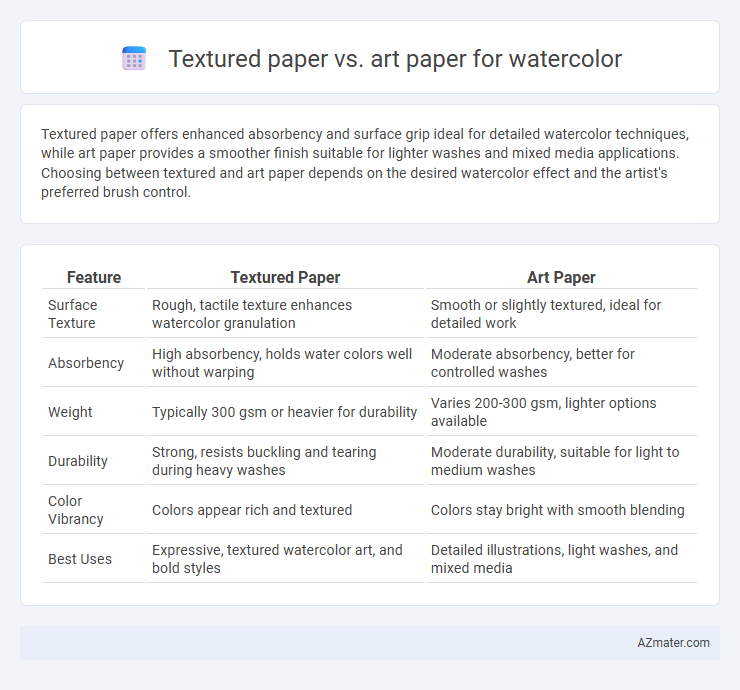Textured paper offers enhanced absorbency and surface grip ideal for detailed watercolor techniques, while art paper provides a smoother finish suitable for lighter washes and mixed media applications. Choosing between textured and art paper depends on the desired watercolor effect and the artist's preferred brush control.
Table of Comparison
| Feature | Textured Paper | Art Paper |
|---|---|---|
| Surface Texture | Rough, tactile texture enhances watercolor granulation | Smooth or slightly textured, ideal for detailed work |
| Absorbency | High absorbency, holds water colors well without warping | Moderate absorbency, better for controlled washes |
| Weight | Typically 300 gsm or heavier for durability | Varies 200-300 gsm, lighter options available |
| Durability | Strong, resists buckling and tearing during heavy washes | Moderate durability, suitable for light to medium washes |
| Color Vibrancy | Colors appear rich and textured | Colors stay bright with smooth blending |
| Best Uses | Expressive, textured watercolor art, and bold styles | Detailed illustrations, light washes, and mixed media |
Introduction to Watercolor Paper Types
Watercolor paper types primarily include textured and art paper, each offering unique surface qualities that affect paint absorption and finish. Textured paper, often cold-pressed, features a rough surface that enhances color granulation and provides a tactile feel ideal for expressive brushwork. Art paper, typically hot-pressed, has a smooth surface that allows for fine detail and even washes, making it suitable for intricate watercolor techniques.
What is Textured Watercolor Paper?
Textured watercolor paper, often known as cold press paper, features a slightly rough surface that enhances paint absorption and creates natural variations in color and tone. This texture allows for greater control of washes and layering, making it ideal for artists seeking depth and subtle effects in their watercolor paintings. In contrast, art paper is typically smoother and less absorbent, offering less texture variation and a different painting experience.
What is Art (Smooth) Watercolor Paper?
Art (Smooth) watercolor paper features a fine-grain surface with minimal texture, providing an even, flat space ideal for detailed brushwork and smooth washes. Unlike textured papers that emphasize pronounced tooth for color absorption and granulation, smooth watercolor paper allows watercolor pigments to glide effortlessly, enabling clear, sharp edges and delicate gradients. This type of paper is preferred for techniques requiring precision, subtle layering, and controlled blending without interference from paper texture.
Surface Differences: Texture vs Smoothness
Textured paper for watercolor features a pronounced, rough surface that enhances paint absorption and creates dynamic, tactile effects, ideal for expressive brushwork and lifting techniques. Art paper, often smoother, offers a flat and even surface that allows fine detail and controlled washes, making it suitable for intricate or layered watercolor applications. The choice between textured and smooth surfaces significantly influences the interaction between pigment and paper, affecting drying time, color intensity, and overall artistic expression.
Paint Absorption and Blending Qualities
Textured paper, often cold-pressed or rough, features pronounced tooth that enhances paint absorption by allowing watercolor pigments to settle into its grooves, producing rich color depth and vibrant texture. Art paper, typically hot-pressed and smooth, offers less absorbency, enabling easier paint blending and fine detail work due to its even surface that prevents pigment from sinking too quickly. Selecting textured paper optimizes bold washes and dynamic effects, while art paper suits delicate layering and subtle gradations in watercolor painting.
Color Vibrancy and Granulation Effects
Textured paper enhances watercolor paintings by amplifying granulation effects and promoting natural pigment settling, resulting in richer color vibrancy and dynamic surface textures. Art paper, often smoother, tends to offer less pronounced granulation but allows for more uniform color application, providing controlled blending and sharper detail. Choosing textured paper maximizes granulation and vibrant hues, while art paper suits artists seeking precision and subtle color transitions in watercolor work.
Handling Techniques: Lifting and Layering
Textured paper offers superior grip for lifting pigments, enabling effective correction and tonal adjustments in watercolor techniques. Art paper, often smoother, allows for delicate layering but requires careful water control to prevent pigment bloom or streaking. Mastery of lifting and layering on these surfaces enhances depth and vibrancy in watercolor artworks.
Artistic Styles Suited for Each Paper
Textured paper enhances abstract and expressive watercolor styles by emphasizing brushstrokes and color gradients, making it ideal for impressionistic and loose techniques. Art paper, with its smoother surface, suits detailed and realistic watercolor paintings where precision and fine lines are essential, such as botanical illustrations and portraiture. Selecting the appropriate paper supports the artist's intended style, maximizing the visual impact of watercolor textures and details.
Durability and Archival Properties
Textured paper for watercolor offers superior durability due to its thicker, more robust fibers that withstand repeated washes and lifting techniques without warping or deteriorating. Art paper, while smoother and ideal for detailed work, often lacks the same archival qualities, making it more prone to yellowing and acid degradation over time. For long-lasting, archival-quality watercolor artwork, textured paper with high cotton content and acid-free certification is the optimal choice.
Choosing the Right Paper for Your Watercolor Project
Textured paper, such as cold-pressed, offers a rough surface ideal for holding multiple layers of watercolor pigment, enhancing color vibrancy and depth, making it suitable for detailed and expressive works. Art paper, typically smoother and less absorbent, works well for washes and delicate techniques but may struggle with heavy pigment application or multiple layers without warping. Selecting between textured and art paper depends on your project's required detail, layering, and paper weight, with 300gsm or heavier papers generally preferred for durability in watercolor painting.

Infographic: Textured paper vs Art paper for Watercolor
 azmater.com
azmater.com